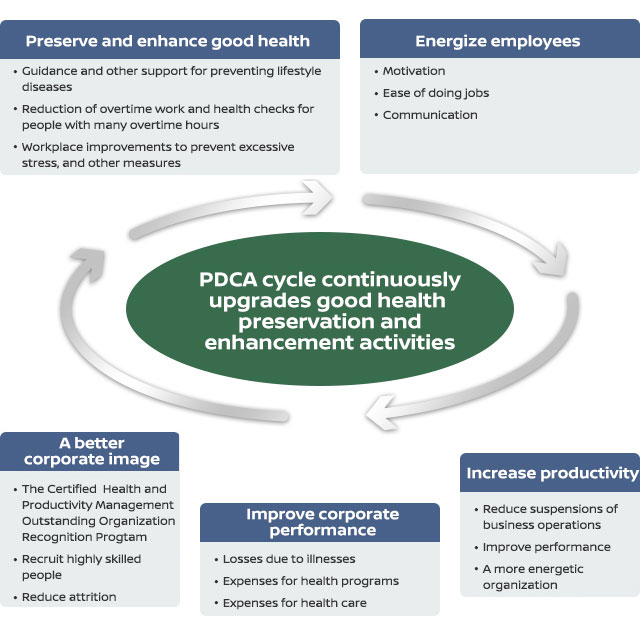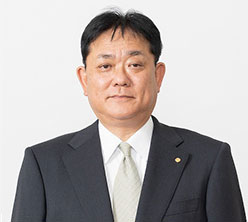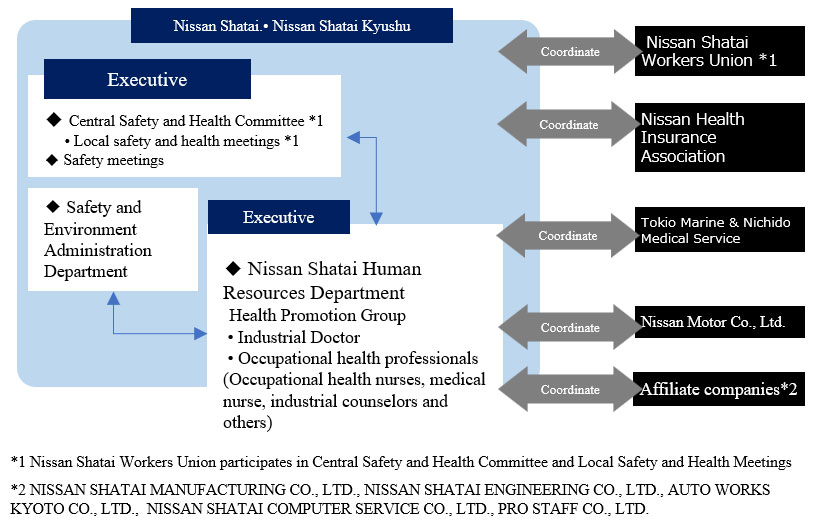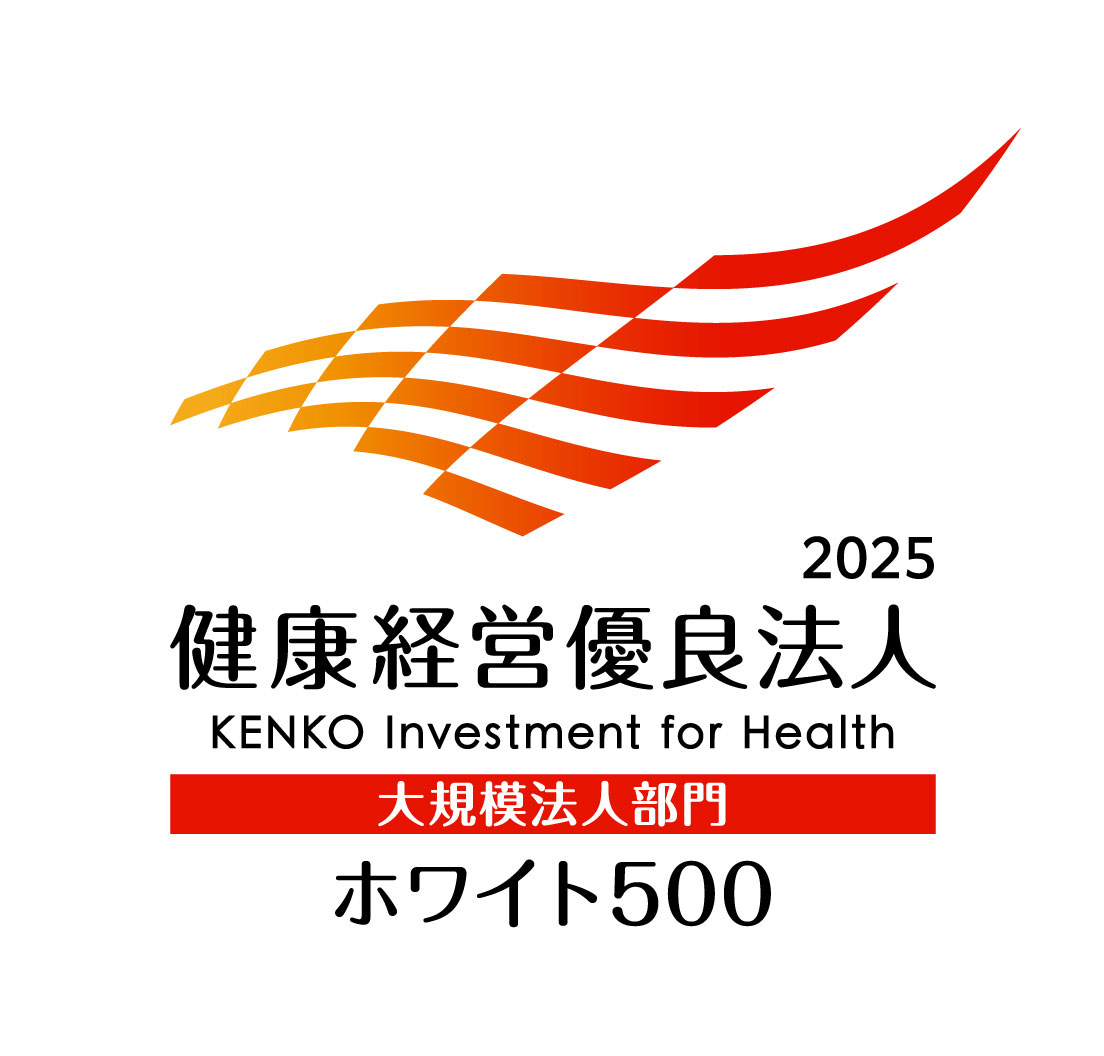Health management
Health management
With a corporate policy that “Only people with sound mind and body are able to work with vigor, peace of mind, and integrity,” Nissan Shatai group arrange operations with industrial physicians, public health nurses, medical nurses, counselors, and others, and cooperate with external specialty agencies, and address health maintenance and enhancement activities as organizational capabilities.
Nissan Shatai Group provides health guidance based on health diagnosis results and conducts food seminars and other events at preventing lifestyle diseases. It also conducts mental health measures such as workplace improvement activities for high stress workplaces based on stress check results and seminars. These data-based efforts have successfully clarified issues and supported activities to prevent mental and physical difficulties ahead of time. It implements the PDCA cycle annually for these activities to review results and intends to deepen and continue activities. Thanks to these efforts, Nissan Shatai and Nissan Shatai Kyushu received certification as a “Health and Productivity Management Organization – White 500” from METI and the Nippon Kenko Kaigi since 2019.

Employees Health
Health Management Activities(Nissan Shatai Co., Ltd., Nissan Shatai Kyushu Co., Ltd.)
[ Health Management Policy ] We recognize that health management is one of our highest priorities for achieving sustained growth. We will continue to strengthen programs for the preservation and enhancement of good health in order to improve productivity and the capabilities of our employees.
[ Nissan Shatai and Nissan Shatai Kyushu Health Declaration ]
Nissan Shatai and Nissan Shatai Kyushu
Health Declaration
~ Only people with sound mind and body are able to work with vigor, peace of mind, and integrity ~
Nissan Shatai and Nissan Shatai Kyushu are creating joy and excitement for their customers and realizing further social contributions through their attractive products.
For that reason, it is necessary for all of their employees to be highly motivated and perform at their full potential.
We are strongly pressing forward with improvement activities designed in response to the views of each and every employee, in order to build a workplace in which the employees cheerfully and healthily respect and help each other.
The company is actively promoting health management so that the employees can understand the building of their mental and physical health to be their own responsibility and take on the challenge enthusiastically.

July 1, 2024
Nissan Shatai Co., Ltd.
Nissan Shatai Kyushu Co., Ltd.
President Takashi Tomiyama
[ Health promotion structure ] Led by the Central Safety and Health Committee, the Health Promotion Group under the Human Resources Department of Nissan Shatai is promoting health maintenance and promotion activities in cooperation with Nissan Shatai workers union, Nissan Shatai Kyusyu workers union, Nissan Health Insurance Association, Tokio Marine & Nichido Medical Service Co.,Ltd., which is a specialized medical institution, and the affiliates of Nissan Motor and Nissan Shatai.

[ Initiatives for health issues ] Our company is carrying out physical and mental health maintenance and promotion activities in line with the health-focused management strategy map and based on a company-wide policy.
- Health Management Strategy Map: Nissan Shatai, Nissan Shatai Kyushu -

For actual data of various indicators related to health management, please refer to the following.
By implementing health guidance, oncology examinations, support for employees working overtime, workplace environment improvements, and various education, we aim to reduce the number of employees taking leave.
Additionally, through taking initiatives of problem-solving, communicating time, and opinion exchange meetings with management, we strive to improve employee satisfaction.
Overall indicators include work engagement, absenteeism, and presenteeism. More specific indicators such as “Total number on leave (taking a full year of leave) and new people on leave,” and “Employee satisfaction” are used to verify the effectiveness of our measures.
At the start of each fiscal year, we review the previous year’s activities and revise various policies as needed, thereby operating a cycle of evaluation and improvement.
In our operations, we constantly aware legal compliance and risk management, and work to promote these efforts.
[ Introduction of examples of physical and mental health maintenance and promotion activities ] We are engaged in activities such as providing education and holding a range of events, etc. to prevent lifestyle-related diseases and mental disorders.
| Prevention stage Examples of activities (physical, mental) |
Primary prevention ·Health promotion ·Prevention in advance |
Secondary prevention ·Early discovery ·Early response |
Tertiary prevention ·Prevention of worsening of illness ·Support for return to the workplace |
|
|---|---|---|---|---|
| Communication of information concerning health |
Physical, mental |
○ | ||
| Physical and mental health education |
Physical, mental |
○ | ||
| Holding of events concerning diet and exercise |
Physical | ○ | ||
| Guidance to warm-up exercises when commencing work from home |
Physical | ○ | ||
| Health follow-up with respect to long working hours |
Physical, mental |
○ | ○ | |
| Workplace environment improvement activities based onx stress check results |
Mental | ○ | ○ | |
| Establishment of a health consultation counter and provision of services by counselors |
Physical, mental |
○ | ○ | ○ |
| Health guidance based on health check results |
Physical | ○ | ○ | ○ |
| Thorough examination follow-up based on health check results |
Physical | ○ | ○ | |
| Support for return to the workplace |
Physical, mental |
○ | ||
[A White 500 Health and Productivity Company (ranking in top 500)]
 Nissan Shatai and Nissan Shatai Kyushu have been continuously recognized and certified as “Certified Health & Productivity Management Organizations – White 500” under the “Certified Health & Productivity Management Organization Recognition Program” jointly promoted by the Ministry of Economy, Trade and Industry and the Japan Health Council—Nissan Shatai since 2019, and Nissan Shatai Kyushu since 2020.
Nissan Shatai and Nissan Shatai Kyushu have been continuously recognized and certified as “Certified Health & Productivity Management Organizations – White 500” under the “Certified Health & Productivity Management Organization Recognition Program” jointly promoted by the Ministry of Economy, Trade and Industry and the Japan Health Council—Nissan Shatai since 2019, and Nissan Shatai Kyushu since 2020.Under the company-wide policy of “Only people with sound mind and body are able to work with vigor, peace of mind, and integrity” Nissan Shatai and Nissan Shatai Kyushu have established a system with industrial physicians, public health nurses, medical nurses, and workplace counselors, and are conducting organizational activities in cooperation with external EAP provider.
In particular, as a health issue, we have been working to reduce the number of employees with findings related to blood lipids, liver function, and high blood pressure by providing health guidance based on health checkup results, as well as conducting initiatives for the prevention of lifestyle-related diseases such as dietary seminars and exercise events. We also continuously carry out activities for mental health, such as workplace environment improvements for high-stress workplaces based on stress check results, mental health measures through training, and better support for employees returning to work after leave, by visualizing issues based on data and engaging in proactive prevention of physical and mental health problems.
For these activities, we operate the PDCA cycle annually to verify results and further deepen and continue our initiatives.
Nissan Shatai and Nissan Shatai Kyushu will continue to promote activities to maintain and improve employee health, and work to create a workplace environment where all employees can demonstrate their abilities to the fullest, work with high motivation, and feel energized.
[Support for Other Companies]
Nissan Shatai and Nissan Shatai Kyushu provide health management support to other companies.Specifically, during health checkups, we collaborate with insurance company to offer cancer prevention education and high blood pressure prevention programs, with participation from partner companies,neighboring companies, and various other staffing agencies.
These companies also join us for influenza vaccination programs.
Additionally, together with the company, which operates our employee cafeteria, and Nissan Health Insurance Association, we co-host cafeteria events. Through initiatives such as dietary education and activities to reduce high blood pressure for our employees and employees of other companies using the cafeteria, we raise awareness of health promotion and support their efforts.
Health management data (Nissan Shatai)
| Nissan Shatai | Target value |
2022 | 2023 | 2024 | Remarks |
|---|---|---|---|---|---|
| New people on leave per 1,000 Physical ※Health Management OUTCOME
|
See right |
3.4 Average of last 4years (2.2)
|
2.4 Average of last 5years (2.8)
|
1.4 Average of last 5years (2.7)
|
Number of employees absent for 30 days or more*1per 1000 employees during the year *1 Lifestyle-related diseases and cancer (gastric, colorectal, pulmonary, gynecological), etc. ( ):target value |
| New people on leave per 1,000 Mental ※Health Management OUTCOME |
See right |
11.0 Average of last 3years (10.7)
|
12.9 Average of last 4years (10.8)
|
16.8 Average of last 5years (11.2)
|
Number of employees absent for 30 days or more*2per 1000 employees during the year *2 Mental illness ( ):target value |
| Presenteeism ※Health Management OUTCOME |
- | 75.3% Ratio of respondents :
87.5% Target of the survey : 1904 |
75.3% Ratio of respondents : 91.7% Target of the survey : 2002 |
74.7% Ratio of respondents : 94.3% Target of the survey : 1863 |
SPQ university of Tokyo one-itemversion Average value of survey subjects who evaluated their own work over the past four weeks, with 100% of the work performed when they were not sick or injured. |
| Work Engagement ※Health Management OUTCOME |
- | 51.5 Ratio of respondents : 87.9% Target of the survey : 1904 |
51.1 Ratio of respondents : 91.9% Target of the survey : 2002 |
51.1 Ratio of respondents : 94.6% Target of the survey : 1863 |
The base deviation value is 50 with FY19 before the coronavirus pandemic, and the lower the value, the better. *We have been understanding the individual situation since FY09 using our own proprietary indicators developed by Nissan Motor Corporation. It has been confirmed that this survey has a strong correlation with the new simplified occupational stress questionnaire (shortened 80-item version). |
| Number of Central Safety and Health Committee held | - | 50 times | 50 times | 50 times | Central Safty and Health Committee : 2 times Local safty and Health meetings : 36 times (12 times×3 areas) Safty meetings : 12 times |
| Rate of stress check attendance | 90% | 88.7% | 93.5% | 95.7% | The ratio of high-stress workers : 14.2% |
| Rate of regular medical check-ups | 100% | 100.0% | 100.0% | 100.0% | |
| Rate of employees having abnormal findings in regular medical check-ups | - | 55.0% | 51.1% | 53.7% | |
| Rate of employees having high blood pressure | - | 0.8% | 0.8% | 0.5% | |
| Rate of employees having carbohydrate metabolism disorders | - | 1.5% | 1.2% | 1.3% | |
| Rate of employees having standard weight | - | 58.6% | 59.9% | 58.8% | |
| Rate of employees having exercise habits | - | 28.6% | 28.3% | 30.3% | |
| Non-smoking rates | - | 70.9% | 70.7% | 70.1% | |
| Medical consultation rete of employee recommended | - | 76.5% | 100.0% | 80.7% | |
| Response rate for medical recommendation notice | - | 100.0% | 98.4% | 100.0% | |
| Rate of medical consultation for high risk employee | - | - | 100.0% | 100.0% | |
| Rate of gynecological cancer screenings | - | 41.0% | 51.0% | 47.0% | |
| Satisfaction rate of health guidance based on health check results | - | 94.4% | 95.4% | 98.0% | |
| Satisfaction rate of employee who attended health promotion eminar | 90% | 97.4% | 96.0% | 98.0% | |
| Participation rate of dietary events | - | 22.2% | 27.0% | 26.7% | |
| Registration rate of health promotion web-based service | 70% | 53.1% | 59.3% | 67.6% | Nissan Motor Co., Ltd. Health Insurance Association recommended health apps |
| Average length of employment | - | 17.9 years | 17.7 years | 16.4 years | |
| Turnover rate | - | 3.1% | 3.4% | 3.7% | |
| Number of holidays taken annually | - | 17.5 days | 17.3 days | 16.3 days | |
| Average overtime (Hours) | - | 20.4 hours | 23.2 hours | 23.5 hours |
Health management data (Nissan Shatai Kyushu)
| Nissan Shatai Kyushu | Target value |
2022 | 2023 | 2024 | Rremarks |
|---|---|---|---|---|---|
| New people on leave per 1,000 Physical ※Health Management OUTCOME
|
See right |
0.0 Average of last 4years (1.0)
|
0.0 Average of last 5years (0.8)
|
0.0 Average of last 5years (0.8)
|
Number of employees absent for 30 days or more*1per 1000 employees during the year *1 Lifestyle-related diseases and cancer (gastric, colorectal, pulmonary, gynecological), etc. ( ):target value |
| New people on leave per 1,000 Mental ※Health Management OUTCOME |
See right |
12.0 Average of last 3years (9.0)
|
10.7 Average of last 4years (9.8)
|
8.1 Average of last 5years (9.9)
|
Number of employees absent for 30 days or more*2per 1000 employees during the year *2 Mental illness ( ):target value |
| Presenteeism ※Health Management OUTCOME |
- | 73.5% Ratio of respondents :
96.5% Target of the survey : 1271 |
73.4% Ratio of respondents : 95.3% Target of the survey : 1241 |
72.9% Ratio of respondents : 96.0% Target of the survey : 1360 |
SPQ university of Tokyo one-itemversion Average value of survey subjects who evaluated their own work over the past four weeks, with 100% of the work performed when they were not sick or injured. |
| Work Engagement ※Health Management OUTCOME |
- | 53.7 Ratio of respondents : 94.5% Target of the survey : 1271 |
53.6 Ratio of respondents : 95.8% Target of the survey : 1241 |
53.8 Ratio of respondents : 96.4% Target of the survey : 1360 |
The base deviation value is 50 with FY19 before the coronavirus pandemic, and the lower the value, the better. *We have been understanding the individual situation since FY09 using our own proprietary indicators developed by Nissan Motor Corporation. It has been confirmed that this survey has a strong correlation with the new simplified occupational stress questionnaire (shortened 80-item version). |
| Number of Central Safety and Health Committee held | - | 26 times | 26 times | 26 times | Central Safty and Health Committee : 2 times Local safty and Health meetings : 12 times Safty meetings : 12 times |
| Rate of stress check attendance | 90% | 97.5% | 99.3% | 98.5% | The ratio of high-stress workers : 14.2% |
| Rate of regular medical check-ups | 100% | 100.0% | 100.0% | 100.0% | |
| Rate of employees having abnormal findings in regular medical check-ups | - | 48.0% | 52.1% | 55.5% | |
| Rate of employees having high blood pressure | - | 1.1% | 0.5% | 0.3% | |
| Rate of employees having carbohydrate metabolism disorders | - | 0.2% | 0.4% | 1.2% | |
| Rate of employees having standard weight | - | 56.4% | 55.3% | 54.3% | |
| Rate of employees having exercise habits | - | 24.1% | 22.0% | 23.2% | |
| Non-smoking rates | - | 48.9% | 49.9% | 46.8% | |
| Medical consultation rete of employee recommended | - | 100.0% | 100.0% | 100.0% | |
| Response rate for medical recommendation notice | - | 100.0% | 100.0% | 100.0% | |
| Rate of medical consultation for high risk employee | - | - | 100.0% | 100.0% | |
| Rate of gynecological cancer screenings | - | 44.0% | 44.0% | 44.0% | |
| Satisfaction rate of health guidance based on health check results | - | 94.1% | 97.1% | 98.0% | |
| Satisfaction rate of employee who attended health promotion eminar | 90% | 97.4% | 96.0% | 98.0% | |
| Participation rate of dietary events | - | 63.8% | 27.0% | 23.0% | |
| Registration rate of health promotion web-based service | 70% | 51.2% | 58.1% | 63.2% | Nissan Motor Co., Ltd. Health Insurance Association recommended health apps |
| Average length of employment | - | 7.7 years | 8.5 years | 8.0 years | |
| Turnover rate | - | 7.9% | 6.8% | 4.5% | |
| Number of holidays taken annually | - | 17.9 days | 18.1 days | 16.1 days | |
| Average overtime (Hours) | - | 25.5 hours | 37.6 hours | 41.9 hours |
For other HR-related data, please refer to the following:
ESG Data